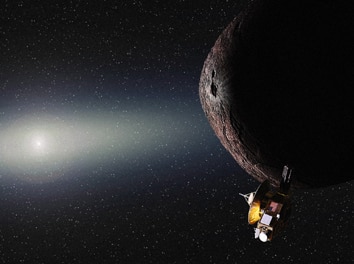Create a free profile to get unlimited access to exclusive videos, sweepstakes, and more!
To Pluto … AND BEYOND!

In July of 2015, the New Horizons space probe will whiz past Pluto, traveling at 40,000 kilometers per hour. For several weeks before and after the close flyby—it’ll pass within 10,000 km above the tiny world’s surface—it will examine Pluto, its moons, and the environment around it.
But this is not an orbiter, or a lander. Pluto is 5 billion kilometers from Earth, and the only way to get a probe there in any decent amount of time was to strip it down as light as possible and fling it as hard as possible, getting it moving so rapidly it could traverse the yawning chasm between us and Pluto as quickly as possible (with a boost from Jupiter along the way).
This is a fast flyby, with no slowing down. Once New Horizons is gone, it’s gone.
Except the solar system hardly ends at Pluto. There’s a vast collection of objects out there in the dark: cold, icy worldlets called Kuiper Belt objects. There are millions of them, relics from the formation of the solar system itself, and largely unchanged for billions of years. Getting a look at one up close is a very tempting goal.
The New Horizons team started a search in 2011 using large ground-based telescopes, and while they found dozens of these KBOs, none was near enough to the probe’s trajectory to investigate. Remember, space is vast and empty—that’s why we call it “space”—and while there may be millions of KBOs, they’re still spread pretty thin out there.
So they turned to Hubble. Narrowing the search but able to detect fainter objects, Hubble was the last hope … and it paid off. They found three potential targets, each over a billion kilometers farther out than Pluto. One, called (for now) PT1 (guess why) should be easy to reach given New Horizons’ present path and fuel supply. Its size is not clear, but based on its brightness and likely surface reflectivity it’s probably more than 30 km (20 miles) in diameter. New Horizons would fly past it in January 2019.
Not that this is a given. Ostensibly, the probe’s mission is over once it flies past Pluto. The team will have to ask NASA for an extension, and those aren’t given out lightly. However, I think this is a very worthy goal. We’ve never seen a pristine KBO up close, just moons we think used to be KBOs but were captured by planets, like Neptune’s Triton and Saturn’s Phoebe. These are likely to have changed over time since they became enthralled to their parent planets, so finding a KBO in its natural habitat is a very exciting idea.
Also, politically, I think it’s a feather in NASA’s cap to be able to retool a space mission to do something more than it was originally designed to do. If things go well at Pluto, and we expect they will, the public will be pretty excited about the mission; folks seem to have a special place in their hearts for the little ice ball. Leveraging that would be pretty smart on NASA’s part.
For details on the search and how they planned this flyby of a KBO, go read Emily Lakdawalla’s write-up. She has (as usual) an excellent and very thorough article about it.
I’m excited about this. I’ve been interested in KBOs since my own days with Hubble; I spent a little bit of time looking into using Hubble to search for objects very far from the Sun, and unfortunately given the logistics at the time (back in the late 1990s) it wouldn’t have really worked. But the cameras are better now, our techniques have improved, and it’s really gratifying to see this getting done. And if PT1 does rate a flyby, we’ll see that little blip in the Hubble image turn into a place, a small but perfect example of what our solar system is like, in the far reaches of nearly—but not quite—empty space.


























